Interagency Spotlight: Bat Monitoring
By Brian Zinke, Newsletter Editor
Winter is often a slow time for most field biologists – unless you work with bats, that is. In fact, winter is arguably one of the most critical times to survey bats. But that also makes it one of the most difficult things to do.
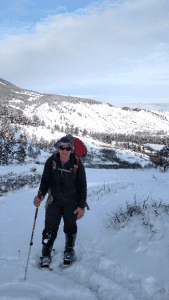
Nongame Bat Biologist Laura Beard snowshoeing to a cave in the Big Horn Mountains. (Photo by Brian Zinke)
Winter bat surveys consist of searching in caves and mines for bats that are hibernating, more commonly referred to as hibernacula surveys. On paper (okay in real life, too), these are really exciting and fun surveys to conduct – crawling through caves, observing hibernating bats, seeing unique cave structures – but they are often very daunting. Caves and mines have inherent dangers, such as hazardous gases, ceiling collapse, and deep shafts, but just getting to the hibernacula can sometimes be a challenge. The Wyoming Game and Fish Department (WGFD), US Forest Service (USFS), and Bureau of Land Management (BLM) each have their own guidelines and safety measures in place for all of these situations, but it’s often the collaboration between agencies that really makes the winter surveys run smoothly.
Perhaps more important (scientifically, anyway), is the collaboration of agencies to benefit and research wildlife. On a group of species such as bats, the duties of monitoring and managing often cross state and federal agency lines. Laura Beard, WGFD’s Nongame Bat Biologist and a 7-year veteran of working with bats in Alaska and Wyoming, understands this relationship well.
“It’s important for natural resource agencies to work together, because in many cases the federal agencies manage the land, and the states are responsible for managing the majority of the wildlife,” says Beard. “For most nongame species, such as bats, we don’t actively manage populations, so making sure that the habitat is managed with these animals in mind is essential. The cooperation in and support for bat work that we’ve received from both the USFS and the BLM in Wyoming is extraordinary.”
Beard is WGFD’s only bat biologist, which means she is responsible for covering the whole state. Developing good working relationships with other agencies is critical for her, and ultimately WGFD’s, success in bat monitoring.
“We rely on the federal management agencies to work in the best interest of bats where caves are concerned,” Beard continues. “For instance, WGFD has no authority to close caves at sensitive times of year. We work with the land management agency to ensure that the needs of the bats are met while still allowing recreation to take place. We try to keep an open dialogue with all of the federal land managers who have bats in their area.”
But it’s a two-way street. The federal agencies also rely on the WGFD for information regarding the bats in their area.
“Frankly, WGFD has provided much needed bat expertise” says Tracy Pinter, a Wildlife Biologist on the USFS Bighorn National Forest. “Bats are animals that are not easily surveyed due to the fact that they are small, flying, and nocturnal. These traits require specialized skills to survey for and identify bat species. Many species of bats look similar, making identification tricky without proper training. Many also hibernate in caves which make them difficult to get to.”
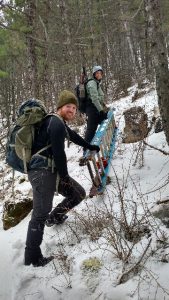
USFS Wildlife Biologist Tracy Pinter (top) and WGFD Nongame Biologist Brian Zinke (bottom) trekking up to a cave in the Big Horn Mountains. (Photo by Laura Beard)
Recently, Beard and Pinter were able to collaborate on their first hibernacula surveys together. And let’s just say, it was a memorable experience. The first cave involved a river crossing and a hike up an extremely steep hill carrying a 16-ft ladder, not to mention it was in the middle of the coldest and snowiest winter Wyoming has seen in a while. The second cave required about a 3-hour snowshoe to reach the entrance. Regardless of the physical difficulties of reaching the caves, the hibernacula surveys were very successful. Hibernating bats were found and substrate samples were collected to monitor for the presence of the fungus that causes White-nose Syndrome (WNS). Wyoming does not have WNS yet, but it has had devastating impacts on the east coast, was found in Washington-state this past year, and recently the fungus was discovered in Texas for the first time. Both Beard and Pinter agree that WNS is of major concern, but it also provides a prime example of the benefits of collaboration.
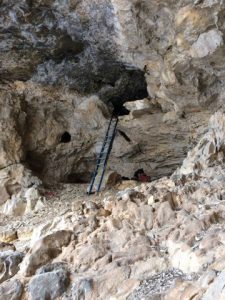
Entrance to a cave in the Big Horn Mountains that required a ladder to access. (Photo by Tracy Pinter)
Interagency collaboration surrounding bats is important because of “the ongoing spread of WNS, increasing habitat loss, and wind energy development [that] threaten bats across the country. As we learn more about how important bats are ecologically and economically, and we see the millions that have been killed in the east by WNS, the challenges facing land management agencies seem daunting. Working together with partners allows us to plan together for the future and challenges that we all face,” says Pinter.
During Beard’s years of bat experience, she’s already witnessed how important the openness and willingness of agencies to work together is.
“On the national scale, it has been the federal agencies that have taken the lead in the WNS response, from coordination to testing and a host of other functions as well,” says Beard. “Federal agencies sometimes have access to resources that the states don’t have. On the other hand, state wildlife managers can get into the field in their state in a way that federal agencies may not be able to. Working together in the face of a potentially devastating disease like WNS is obviously critical, and it’s a lesson that the bat world seems to have learned well, but I hope that the partnerships that have arisen from this crisis would remain in place even if the fungus were to recede.”
Beard and Pinter plan to continue working together to monitor bats in the Big Horn Mountains, and are looking forward to their next snowy trek to a cave together.
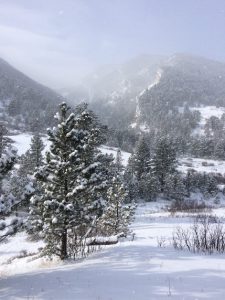
View while snowshoeing to a cave in the Big Horn Mountains. (Photo by Tracy Pinter)
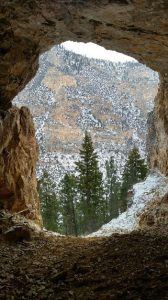
View from the entrance of a cave in the Big Horn Mountains. (Photo by Laura Beard)
Beard and Pinter are both members of the Wyoming Chapter of The Wildlife Society.
 Brian Zinke, AWB®, is a pygmy rabbit biologist for the Washington Department of Fish and Wildlife, where he plays an integral role in the restoration of the endangered Columbia Basin population. Prior to that, he served as a Nongame Biologist with the Wyoming Game and Fish Department for nearly three years.
Brian Zinke, AWB®, is a pygmy rabbit biologist for the Washington Department of Fish and Wildlife, where he plays an integral role in the restoration of the endangered Columbia Basin population. Prior to that, he served as a Nongame Biologist with the Wyoming Game and Fish Department for nearly three years.


